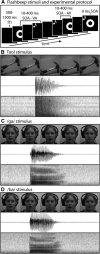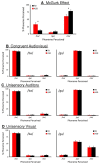Multisensory temporal integration in autism spectrum disorders
- PMID: 24431427
- PMCID: PMC3891950
- DOI: 10.1523/JNEUROSCI.3615-13.2014
Multisensory temporal integration in autism spectrum disorders
Abstract
The new DSM-5 diagnostic criteria for autism spectrum disorders (ASDs) include sensory disturbances in addition to the well-established language, communication, and social deficits. One sensory disturbance seen in ASD is an impaired ability to integrate multisensory information into a unified percept. This may arise from an underlying impairment in which individuals with ASD have difficulty perceiving the temporal relationship between cross-modal inputs, an important cue for multisensory integration. Such impairments in multisensory processing may cascade into higher-level deficits, impairing day-to-day functioning on tasks, such as speech perception. To investigate multisensory temporal processing deficits in ASD and their links to speech processing, the current study mapped performance on a number of multisensory temporal tasks (with both simple and complex stimuli) onto the ability of individuals with ASD to perceptually bind audiovisual speech signals. High-functioning children with ASD were compared with a group of typically developing children. Performance on the multisensory temporal tasks varied with stimulus complexity for both groups; less precise temporal processing was observed with increasing stimulus complexity. Notably, individuals with ASD showed a speech-specific deficit in multisensory temporal processing. Most importantly, the strength of perceptual binding of audiovisual speech observed in individuals with ASD was strongly related to their low-level multisensory temporal processing abilities. Collectively, the results represent the first to illustrate links between multisensory temporal function and speech processing in ASD, strongly suggesting that deficits in low-level sensory processing may cascade into higher-order domains, such as language and communication.
Keywords: audiovisual; autism spectrum disorders; multisensory integration; sensory processing; speech perception; temporal processing.
Figures




Comment in
-
Explaining autism spectrum disorders: central coherence vs. predictive coding theories.J Neurophysiol. 2014 Dec 1;112(11):2669-71. doi: 10.1152/jn.00242.2014. Epub 2014 May 28. J Neurophysiol. 2014. PMID: 24872530
Similar articles
-
The development of multisensory integration in high-functioning autism: high-density electrical mapping and psychophysical measures reveal impairments in the processing of audiovisual inputs.Cereb Cortex. 2013 Jun;23(6):1329-41. doi: 10.1093/cercor/bhs109. Epub 2012 May 24. Cereb Cortex. 2013. PMID: 22628458 Free PMC article.
-
Evidence for diminished multisensory integration in autism spectrum disorders.J Autism Dev Disord. 2014 Dec;44(12):3161-7. doi: 10.1007/s10803-014-2179-6. J Autism Dev Disord. 2014. PMID: 25022248 Free PMC article. Clinical Trial.
-
Atypical rapid audio-visual temporal recalibration in autism spectrum disorders.Autism Res. 2017 Jan;10(1):121-129. doi: 10.1002/aur.1633. Epub 2016 May 9. Autism Res. 2017. PMID: 27156926 Free PMC article.
-
Keeping time in the brain: Autism spectrum disorder and audiovisual temporal processing.Autism Res. 2016 Jul;9(7):720-38. doi: 10.1002/aur.1566. Epub 2015 Sep 24. Autism Res. 2016. PMID: 26402725 Review.
-
Multisensory temporal binding window in autism spectrum disorders and schizophrenia spectrum disorders: A systematic review and meta-analysis.Neurosci Biobehav Rev. 2018 Mar;86:66-76. doi: 10.1016/j.neubiorev.2017.12.013. Epub 2018 Jan 6. Neurosci Biobehav Rev. 2018. PMID: 29317216
Cited by
-
A Randomized Controlled Trial for Audiovisual Multisensory Perception in Autistic Youth.J Autism Dev Disord. 2023 Nov;53(11):4318-4335. doi: 10.1007/s10803-022-05709-6. Epub 2022 Aug 26. J Autism Dev Disord. 2023. PMID: 36028729 Free PMC article. Clinical Trial.
-
Commentary: Visual Fixation in Human Newborns Correlates with Extensive White Matter Networks and Predicts Long-Term Neurocognitive Development.Front Neurosci. 2016 May 18;10:215. doi: 10.3389/fnins.2016.00215. eCollection 2016. Front Neurosci. 2016. PMID: 27242419 Free PMC article. No abstract available.
-
Environmental Enrichment Therapy for Autism: Outcomes with Increased Access.Neural Plast. 2016;2016:2734915. doi: 10.1155/2016/2734915. Epub 2016 Sep 18. Neural Plast. 2016. PMID: 27721995 Free PMC article. Clinical Trial.
-
Multisensory integration: flexible use of general operations.Neuron. 2014 Mar 19;81(6):1240-1253. doi: 10.1016/j.neuron.2014.02.044. Neuron. 2014. PMID: 24656248 Free PMC article. Review.
-
Processing of Real-World, Dynamic Natural Stimuli in Autism is Linked to Corticobasal Function.Autism Res. 2020 Apr;13(4):539-549. doi: 10.1002/aur.2250. Epub 2020 Jan 16. Autism Res. 2020. PMID: 31944557 Free PMC article.
References
-
- American Psychological Association. Diagnostic and statistical manual of mental disorders-IV-TR. Washington, DC: American Psychological Association; 2000.
-
- Bastien-Toniazzo M, Stroumza A, Cavé C. Audio-visual perception and integration in developmental dyslexia: an exploratory study using the McGurk effect. Curr Psychol Lett. 2009:25.
-
- Brandwein AB, Foxe JJ, Butler JS, Russo NN, Altschuler TS, Gomes H, Molholm S. The development of multisensory integration in high-functioning autism: high-density electrical mapping and psychophysical measures reveal impairments in the processing of audiovisual inputs. Cereb Cortex. 2013;23:1329–1341. doi: 10.1093/cercor/bhs109. - DOI - PMC - PubMed
Publication types
MeSH terms
Grants and funding
LinkOut - more resources
Full Text Sources
Other Literature Sources
